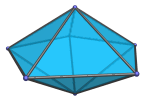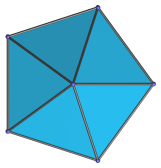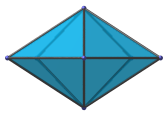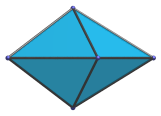The Pentagonal Bipyramid
The pentagonal bipyramid is the 13th Johnson solid (J13). It has 7 vertices, 15 edges, and 10 faces (10 equilateral triangles).

The pentagonal bipyramid can be constructed by attaching two pentagonal pyramids to each other at their bases.
The dual of J13 is a non-uniform pentagonal prism, with longer edges along its axis of symmetry than the edges in the pentagonal caps. The edge length ratio is √(25−11√5) : √2, or approximately 0.449 : 1. Thus, J13 is not to be confused with the dual of a uniform pentagonal prism, also a pentagonal bipyramid but with isosceles triangles rather than equilateral triangles as faces.
Projections
Here are some views of the pentagonal bipyramid from various angles:
| Projection | Envelope | Description |
|---|---|---|
 |
Regular pentagon | Top view. |
 |
Rhombus | Side view. |
 |
Tetragon | Front view. |
Coordinates
The Cartesian coordinates of the pentagonal bipyramid with edge length 2 are:
- (0, 0, ±√((10−2√5)/5))
- (√((10+2√5)/5), 0, 0)
- (√((5−√5)/10), ±φ, 0)
- (−√((5+2√5)/5), ±1, 0)
where φ=(1+√5)/2 is the Golden Ratio.
Occurrences
The pentagonal bipyramid occurs as cells in some CRF polychora, including (but not limited to):




